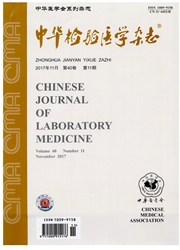

 中文摘要:
中文摘要:
目的:探讨重庆地区正常妊娠妇女不同孕龄甲状腺功能特异性参考区间及动态变化。方法采用自我纵向序列研究及横断面研究相结合的方法,采集2014年6月至2015年9月在重庆第三军医大学大坪医院正常产检的640例不同孕龄的妊娠妇女的血清,应用化学发光法测定血清游离三碘甲状腺原氨酸(FT3)、游离甲状腺素(FT4)、促甲状腺素(TSH)水平,首次筛查同时测定甲状腺过氧化酶抗体(TPOAb)、甲状腺球蛋白(TG)、甲状腺球蛋白抗体(TGAb)。根据2012年国内《妊娠和产后甲状腺疾病的诊治指南》推荐的甲状腺指标参考区间制作方法,以检测结果的第2.5百分位数至第97.5百分位数作为参考区间。计量资料采用χ2检验进行统计分析。结果重庆地区妊娠期不同孕龄甲状腺功能的正常参考区间:孕6~9+6周:FT33.68~5.59 pmol /L、FT49.34~17.02 pmol /L、TSH 0.18~5.26 mIU/L;孕10~13+6周:FT33.69~6.03 pmol /L、FT48.42~15.75 pmol /L、TSH 0.09~4.85 mIU/L;孕14~27+6周:FT33.24~5.46 pmol/L、FT46.50~14.24 pmol /L、TSH 0.11~5.13 mIU/L;孕30~34周:FT33.06~5.05 pmol /L、FT46.12~11.69 pmol /L、TSH 0.75~3.67 mIU/L;孕36~40周:FT32.96~5.00 pmol/L、FT46.26~11.36 pmol/L、TSH 0.84~5.54 mIU/L。分别采用美国甲状腺协会的标准、本实验室建立的标准发现甲状腺功能异常患病率各为37.07%(195例)和8.75%(46例),χ2=120.5,P =0.000,差异有统计学意义。总过度诊断率为28.32%(149/526)。分别采用美国甲状腺协会的标准和本实验室建立的标准首次筛查发现在正常人群中各自筛查出甲状腺功能异常的病例为116例(22.05%)和30例(5.70%),而首次筛查结果正常的人群中在孕中晚期重复筛查,筛查出甲状腺功能异常的病例
 英文摘要:
英文摘要:
Objective To investigate the gestation-specific reference intervals (GRIs) and dynamic changes of thyroid function at different gestational ages in Chongqing .Methods Combining self-sequential longtitudinal with cross-sectional study, the serum samples from 640 pregnant women with different gestational age were collected from June 2014 to September 2015 in the Third Military Medical University. The free triiodothyronine (FT3), free thyroxine (FT4), thyroglobulin (TG), thyroid-stimulating hormone (TSH), thyroid peroxidase antibody (TPOAb), and antithyroglobulin antibody (TGAb) were detected by the direct chemiluminescence method.According to China Guideline for the diagnosis and treatment of thyroid disease in pregnancy and postpartum in 2012, the reference interval of the thyroid function was calculated.The data were analyzed by Chi square test .Results Established GRIs of thyroid function during pregnancy in Chongqing:The GRIs was 3.68-5.59 pmol/L for FT3, 9.34-17.02 pmol /L for FT4, 0.18-5.26 mIU/L for TSH in 6-9+6 weeks of pregnancy; the GRIs was 3.69-6.03 pmol /L for FT3, 8.42-15.75 pmol/L for FT4、0.09-4.85 mIU/L for TSH in 10-13+6 weeks of pregnancy; the GRIs was 3.24-5.46 pmol /L for FT3, 6.50-14.24 pmol/L for FT4, 0.11-5.13 mIU/L for TSH in 14-27+6 weeks of pregnancy;the GRIs was 3.06-5.05 pmol /L for FT3, 6.12-11.69 pmol/L for FT4, 0.75-3.67 mIU/L for TSH in 30-34 weeks of pregnancy; the GRIs was 2.96-5.00 pmol/L for FT3, 6.26-11.36 pmol /L for FT4, 0.84-5.54 mIU/L for TSH in 36-40 weeks of pregnancy.Screening by GRIs, the prevalence of thyroid dysfunction was 8.75% (46), however, the prevalence was 37.07% (195) in according with the guidelines,χ2 =120.5,P =0.000.The overdiagnosis rate was 28.32%(149 /526).Using the guidelines of thyroid disease and our GRIs, the thyroid disease was found 116 (22.05%) and 30 (5.70%) in the first screening. Moreover, the thyroid disease was found 79(19.27%) and 10(3.23%) during the repeat screeni
 同期刊论文项目
同期刊论文项目
 同项目期刊论文
同项目期刊论文
 期刊信息
期刊信息
